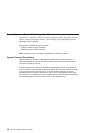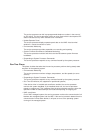
Console Mirroring
Console mirroring allows a user on one serial port to monitor the service processor
activities on another serial port. This can be done on the locally attached HMC virtual
terminal window or windows remotely attached through modems. Console mirroring is
supported on any combination of locally or remotely attached monitors.
The serial port from which console mirroring is enabled is called the
primary port
. The
mirror port is determined when keyboard input is detected from one of the other two
serial ports. From this point forward, the service processor sends information to the
active port and the mirror port only. Console mirroring ends when the service processor
releases control of the serial ports to the system firmware.
Console mirroring is supported on serial port 1 (S1), serial port 2 (S2), and serial port 3
(S3). Remote attachment through a modem is supported on serial port 1 (S1) and serial
port 2 (S2).
System Configuration
The following describes the configuration for console mirroring:
v Service processor
v Modem connected to one serial port and enabled for incoming calls
v Local HMC virtual terminal window connected to the other serial port. This local
terminal can be connected directly to your server or connected through another
modem.
Console mirroring can be started by either of the following methods:
v Remote session first, then local session added:
1. Remote session is already in progress.
2. Remote user uses service processor menus to enable console mirroring, allowing
both consoles to be active.
v Local session first, then remote session added:
1. Local session is already in progress.
2. The service processor receives a call from the remote user.
3. The local user selects the option to enable console mirroring. The service
processor immediately begins mirroring service processor menus.
Chapter 3. Using the Service Processor 59


















